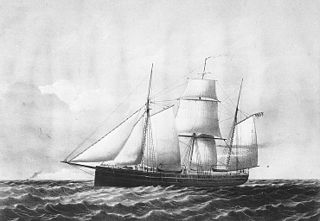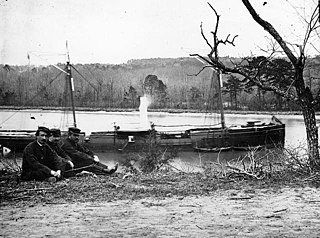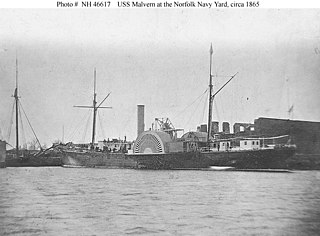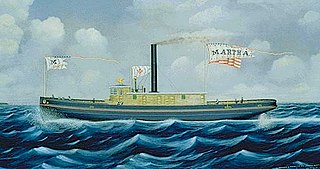
The first USS Sassacus, a wooden, double-ended, side-wheel steamer, was launched on 23 December 1862 by the Portsmouth Naval Shipyard in Kittery, Maine, sponsored by Miss Wilhelmina G. Lambert. Sassacus was commissioned at the Boston Navy Yard on 5 October 1863, Lieutenant Commander Francis A. Roe in command.

USS James Adger was a sidewheel steamer in the Union Navy during the American Civil War. She retained her former name.

USS Niphon was a steam operated vessel acquired by the Union Navy during the American Civil War. She was used by the Navy to patrol navigable waterways of the Confederacy to prevent the South from trading with other countries.

USS Kansas was a gunboat constructed for the Union Navy during the middle of the American Civil War. She was outfitted with heavy guns and assigned to the Union blockade of the waterways of the Confederate States of America. She was the first U.S. Navy ship to be named Kansas and was the first of a class of 836-ton screw steam gunboats. At war's end, she continued serving her country by performing survey work and defending American interests in Cuba until sold in 1883.

The first USS Mount Vernon was a wooden-screw steamer in the United States Navy.

USS Wilderness was a wooden-hulled, side-wheel steamship in the United States Navy during the American Civil War. After the war, she served as a revenue cutter. In 1873, she was renamed John A. Dix for former Secretary of the Treasury John Adams Dix.

USS Unadilla was a Unadilla-class gunboat built for service with the United States Navy during the American Civil War. She was the lead ship in her class.

USS Aries was an 820-ton iron screw steamer built at Sunderland, England, during 1861–1862, intended for employment as a blockade runner during the American Civil War. She was captured by Union Navy forces during the Union blockade of the Confederate States of America, and was commissioned as a Union gunboat. Aries was named for the constellation.

USS Howquah was a screw steamer purchased by the Union Navy in Boston from G. W. Upton on 17 June 1863, for action against Confederate commerce raider CSS Tacony which was then preying upon Northern merchantmen during what Professor Richard S. West has called "the most brilliant daredevil cruise of the war."
The USS Governor Buckingham was a hermaphrodite brig in the United States Navy during the American Civil War. The ship was built under contract by Messrs Maxon Fish & Co., Mystic, Conn., and was offered for sale to the Navy while on the ways; purchased at Stonington, Connecticut, 29 July 1863 by Isaac Henderson for $110,000; delivered at New York Navy Yard 30 September 1863; and commissioned 13 November 1863, Acting Volunteer Lt. W. G. Saltonstall in command. She was assigned to the North Atlantic Blockading Squadron, with instructions to report at Hampton Roads to Acting Rear Admiral S. P. Lee. The ship was probably named for the Governor of Connecticut, William Alfred Buckingham.
USS Zouave was a steamer acquired by the Union Navy during the American Civil War. She was needed by the Navy to be part of the fleet of ships to prevent blockade runners from entering ports in the Confederacy.

USS Malvern was a large steamer captured by the Union Navy during the American Civil War. She was then used by the Union Navy to patrol navigable waterways of the Confederacy to prevent the South from trading with other countries.
USS Aster was a steam operated tugboat acquired by the Union Navy during the American Civil War. She was used by the Navy to patrol navigable waterways of the Confederacy to prevent the South from trading with other countries.

USS Genesee was a steamer acquired by the Union Navy during the American Civil War. She was used by the Navy to patrol navigable waterways of the Confederacy to prevent the South from trading with other countries.
USS Britannia was a steamer captured by the Union Navy during the American Civil War. She was used by the Union Navy as a gunboat and patrol vessel in support of the Union Navy blockade of Confederate waterways.
The first USS Anemone was a steamer acquired by the Union Navy during the American Civil War. She was used by the Union Navy as a tugboat in support of the Union Navy blockade of Confederate waterways.
USS State of Georgia was a large steamer with powerful guns acquired by the Union Navy during the American Civil War. State of Georgia, with her crew of 113 sailors and officers, was used by the Union Navy as a gunboat in its blockade of Confederate waterways.
USS Victoria was a steamer acquired by the Union Navy during the American Civil War.
USS Shokokon was a large (709-ton) steamer with powerful 30-pounder rifled guns, purchased by the Union Navy during the beginning of the American Civil War.

USS Violet was a 166-ton steamer acquired by the U.S. Navy for use during the American Civil War.










